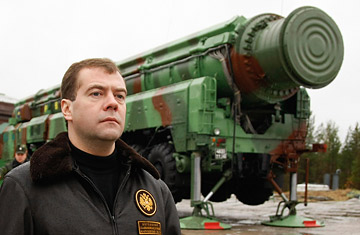
President Medvedev walks near an RS-12M Topol ballistic missile at the Plesetsk space-launch pad
Barack Obama has declared a goal of a world free of nuclear weapons. But moving toward zero is going to be difficult, even with the U.S. President's having agreed with his Russian counterpart to restart nuclear-disarmament negotiations, and specifically to try to replace the 1992 Strategic Arms Reduction Treaty (START). The goal of any arms treaty would seem simple enough: reduce the number of weapons. But the dirty little secret about nuclear weapons is that the fewer of them you have, the more difficult it becomes to get rid of them. Big arsenals are inherently more stable than little arsenals, and are easier to cut. (See a graphic of the nuclear-armed world.)
That's why the first step will likely be a modest one. Traditional deterrence theory holds that a country should keep as many nuclear weapons as it would need in an absolute worst-case scenario, one in which it had to destroy the war-fighting capacity of multiple adversaries. The Russians have made clear that they want a START replacement to limit delivery systems (intercontinental ballistic missiles, submarine-launched missiles and bombers), but American war planners may resist drastic cuts in that area because of concern that the U.S. might lose the ability to deter multiple enemies at once. "China is approaching 200 warheads on ballistic missiles and building a force that the U.S. intelligence community fears could double in the next 15 years," explains Hans Kristensen of the Federation of American Scientists. "Under this scenario, U.S. war planners worry that they would not be able to handle multiple contingencies if they have too few weapons: they wouldn't be able to deter Russia, China and potential regional actors simultaneously." If he's serious about even approaching zero, Obama will have to impose a strategic doctrine on the military that moves away from such Cold War paranoia and mistrust. As one former high-ranking U.S. State Department official who was part of the original START negotiations told TIME, "Worst-case war planners should not dictate to the President a force structure which exceeds all plausible needs." (See the world's top 10 worst nuclear disasters.)
Further handicapping proceedings is intense time pressure. START expires in December of this year, meaning that an agreement will need to be reached by August if the treaty is to be approved by the U.S. Senate prior to START's expiration. Then there is an even more basic problem. "Over the past decade," says Steve Andreasen, a former director for arms control on the National Security Council, "many of the career officials experienced in these issues have left government, and they have not been replaced during an era when arms control was not a priority." Peter Zimmerman, former chief scientist of the Senate Foreign Relations Committee, calls this a "serious problem," adding that "the President must make sure the American delegation is packed with fast learners if he cannot persuade some of the experienced people to return to duty."
Striking the right tone for these negotiations is yet another challenge. Andreasen says that "both sides will want to avoid the Cold War dynamic of large, permanent delegations gathering in Geneva and facing off across a large table, pencils sharpened." But, he says, they must also acknowledge that "they have legitimate concerns regarding the size, posture and security of the other side's nuclear arsenals." The most likely sticking point will be agreeing on how to count nuclear weapons: specifically, whether to count all the weapons each country could potentially use or only the ones that are ready at the time of negotiations.
The original START treaty opted for the former approach, setting absolute limits of 6,000 warheads and 1,600 intercontinental ballistic missiles, submarine-launched ballistic missiles and bombers per side. But the most recent nuclear-arms-control agreement, the 2002 "Moscow Treaty," settled on the more nebulous measure of "operationally deployed warheads" (of which both sides are allowed 2,200). That way of counting, which the Russian government and some American arms-control advocates now oppose, measures only the number of nuclear weapons on the tips of long-range missiles or on bomber bases. Most long-range missiles are capable of carrying multiple, independently targeted warheads, and long-range bombers rarely fly with full payloads. So the "operationally deployed warhead" measure doesn't count the stockpile of warheads that both the U.S. and Russia could load onto existing missiles and bombers. In deterrence theory, this raises the possibility of one side or the other achieving a "breakout capacity," meaning that it could quickly and quietly beef up its arsenal until it became capable of launching a devastating "first strike." First-strike capability is dangerous because it is not "crisis stable": it could encourage a preemptive nuclear attack during a tense standoff. (See pictures of a world-class nuclear bunker in West Virginia.)
It may seem absurd, but war planners in both countries, though ostensibly no longer adversaries, care very much about even the smallest incremental adjustments that would alter nuclear parity. And so not just the tone of negotiations but their goal must be set just right. Zimmerman and other arms-control experts argue that a good deal for a new treaty would be to keep the counting and robust verification system of the START treaty in place, but with a moderate goal of reducing the number of weapons. Obama himself has indicated that he favors a modest first step. At the Carnegie International Nonproliferation Conference in Washington on April 7, arms-control experts were both exuberant over Obama's call to eradicate nuclear weapons and unsure how such an ambitious end-goal might be achieved. "It's been a long time since we felt this level of excitement," Kristensen says. "But now the question that has always seemed frustratingly hypothetical needs a clear answer: how can we actually make this happen?"
